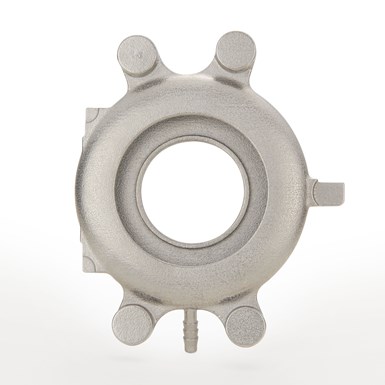The Value of a "Pathfinder Part" for Additive Manufacturing
Implementing additive manufacturing means starting somewhere. Seeking out the right pathfinder part can illustrate valuable lessons about the advantages of this technology.
Share








Takumi USA
Featured Content
View More

Hwacheon Machinery America, Inc.
Featured Content
View More“If you think about the legacy platforms that our Department of Defense has across the board, when something comes out of service there’s a cost to that. There’s a cost to the taxpayer; there’s a cost to the warfighter,” says Brian Morrison. “There are so many different applications out there where additive can solve a problem to get these legacy platforms back to work.”
Morrison is director of additive manufacturing (AM) for Allegheny Technologies Inc. (ATI), a position where he has led the company’s development of titanium and nickel alloys for metal 3D printing. In this role he also works closely with Rich Merlino, senior director of AM and the leader of ATI’s parts production business. Both areas of the business inform each other; the production team can call on material expertise to select powders or create new alloys when needed, while the materials team gets insight into real customer challenges and applications from the production side.
Together Morrison and Merlino have seen customers make the leap to additive, and what makes an application a good fit for AM. Ideally, they say, a company’s first step with additive manufacturing for production should be a pathfinder part — that is, a component similar to other parts in the company’s inventory such that pursuing 3D printing as a production method helps pave the way for future parts.
What makes a good pathfinder part? There are several contributing factors to take into account:
- The part solves a problem. ATI has seen that specific needs are always the best use cases for additive manufacturing. Without an urgent problem to solve, companies can spend years researching and investigating 3D printing without making any real move.
- The problem can only be solved with 3D printing. “When a customer says, ‘I have a component and it’s made this way today and it’s going fine but I want to explore additive,’ that’s not going to go anywhere,” Merlino says. But if that customer has already tried and discarded machining, casting, fabricating and any other option, additive manufacturing tends to succeed.
- The design can be flexible to the needs of both AM and finish machining. Depending on the process used, additive manufacturing may require certain changes or accommodations in the design. Material might need to be removed for instance to save time in printing, or maybe added to help with locating the part for finish machining. Some design flexibility is generally necessary to create a successful pathfinder part.
The as-printed oil collector. ATI had free rein in the design of this upgrade part, but concessions were made for the EBM process and to support finish machining. More.
One last but significant note: The pathfinder part need not be a component that already exists. Brand-new parts often represent the greatest opportunity because of their complete design freedom. With no incumbent processes or tooling to contend with, additive manufacturing is free to deliver the best possible solution.
This was the case with one recent example, an oil collector that ATI created with electron beam melting (EBM). The piece is an upgrade for a fleet of helicopters that were suffering from oil leakage. Though the part was a new one, it proved to be a good case for metal AM and helped the customer learn how to include additive in the design philosophy going forward. Learn much more about this component in this article.
8 Cool Parts from RAPID + TCT 2021: The Cool Parts Show #32
Prefer a visual? The ATI oil collector was one of the items on display at this year’s RAPID + TCT, the largest trade show in North America devoted to 3D printing technology. The part made it into this special episode of The Cool Parts Show highlighting some of the most interesting 3D printed things we found on the show floor.
Related Content
Bavius Technologie Appoints New President, Schedules Technology Showcase
Roy D. Cripps will lead the team at Bavius as it aims to expand its current business in aerospace structures and develop new market segments. Additionally, the company will showcase its technology during an open house event on June 11.
Read MoreMachine Monitoring Boosts Aerospace Manufacturer's Utilization
Once it had a bird’s eye view of various data points across its shops, this aerospace manufacturer raised its utilization by 27% in nine months.
Read MoreGrob Systems Inc. to Host Tech Event With Industry Partners
The 5-Axis Live technology event will highlight new machining strategies for optimizing the production of complex medical, aerospace and mold/die parts.
Read MoreHow a Custom ERP System Drives Automation in Large-Format Machining
Part of Major Tool’s 52,000 square-foot building expansion includes the installation of this new Waldrich Coburg Taurus 30 vertical machining center.
Read MoreRead Next
Building Out a Foundation for Student Machinists
Autodesk and Haas have teamed up to produce an introductory course for students that covers the basics of CAD, CAM and CNC while providing them with a portfolio part.
Read More5 Rules of Thumb for Buying CNC Machine Tools
Use these tips to carefully plan your machine tool purchases and to avoid regretting your decision later.
Read MoreRegistration Now Open for the Precision Machining Technology Show (PMTS) 2025
The precision machining industry’s premier event returns to Cleveland, OH, April 1-3.
Read More
.jpg;width=70;height=70;mode=crop)























.png;maxWidth=150)
























